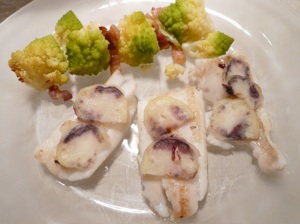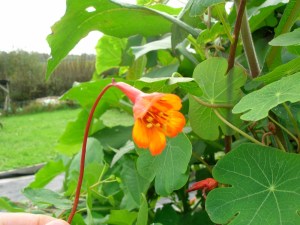Mashua, Tropaeolum tuberosum is probably the Andean region’s fourth most important root crop – after Potato, Oca, and Ulluco. Its cultivation is thought to have been spread by pre-Columbian migrations to Colombia and northern Argentina and Chile. Mashua is an annual, herbaceous climber that belongs to the family Tropaeolaceae which includes about 100 species. Tropaeolum tuberosum grows to over 1-1.5 m in diameter and 0.5-0.8 m high with slender and cylindrical aerial stems. Both erect and prostrate forms of Mashua are known.
Mashua repels many insects, nematodes, and other pathogens, thus making it a valuable plant to intercrop with other species. Yet, in spite of its productivity, pest resistance, and popularity, Mashua is not widely commercialized – either in its native land or elsewhere. Mashua is cultivated in the Andean highlands from 2600 to 4000 m with the best yields of 30,000 kg/ha a year obtained at 3000 m altitude. A single plant can yield 4 kg of tubers, and has a short life cycle of 5-6 months which allows two harvests per year.
 Its tubers can be found in almost any rural Andean market. This perennial plant is closely related to the garden nasturtium. In fact, these two beautiful plants are often found together in Andean gardens, one grown for its edible tubers, the other for its pretty and edible flowers. The tubers, about the size of small potatoes have shapes ranging from conical to carrot like. Mashwa is important for meeting the food requirements of resource-poor people in marginal rural areas of the high Andes.
Its tubers can be found in almost any rural Andean market. This perennial plant is closely related to the garden nasturtium. In fact, these two beautiful plants are often found together in Andean gardens, one grown for its edible tubers, the other for its pretty and edible flowers. The tubers, about the size of small potatoes have shapes ranging from conical to carrot like. Mashwa is important for meeting the food requirements of resource-poor people in marginal rural areas of the high Andes.
 Eaten raw, some have a peppery taste reminiscent of hot radishes. But when boiled, they lose their sharpness and become mild even sweet. It is prepared in the form of a stew, as a roast or in the form of ‘thayacha’. For the latter preparation, the tubers are exposed overnight to frost and are eaten the following day accompanied by sugar-cane syrup.
Eaten raw, some have a peppery taste reminiscent of hot radishes. But when boiled, they lose their sharpness and become mild even sweet. It is prepared in the form of a stew, as a roast or in the form of ‘thayacha’. For the latter preparation, the tubers are exposed overnight to frost and are eaten the following day accompanied by sugar-cane syrup.
Cultivated Mashwa, just like Ullucu and Oca, has been collected extensively in Peru, Ecuador and Bolivia during the last ten years. The field collections of Peru. stored and evaluated in the gene banks of Ayacucho, Cajamarca, Huancayo, Cuzco and Puno, exceed 300 accessions. Many of the accessions are kept ‘in vitro’ in the biotechnological laboratory of the Universidad Nacional Mayor San Marcos in Lima. The field collection of Ecuadorian mashwa is stored and evaluated at the Santa Catalina experimental station in Quito.
 Fillets of Lemon Sole at the Tuberose Nasturtium
Fillets of Lemon Sole at the Tuberose Nasturtium
*Jacques Perrin*
Ingredients
600 g fillet of flounder
1 Romanesco
80 g smoked bacon
1 bitter chicory
200 g bulgur
balsamic vinegar
Preparation
Cook your bulgur in a little broth. Cut the bacon finely and grill it. Blot on paper towels. Cut the bitter endive into thin strips. Bake steam the romanesco ensuring that it stays a little crunchy. Salt and pepper. Keep warm. Saute quickly bitter chicory in a little olive oil. Add a little balsamic vinegar (or vinegar Celtic) to alleviate a little bitterness. Mix the bulgur with chicory. Cut the rhizome tuberous nasturtium into thin slices (like ginger). Fry quickly over medium heat, the flounder fillets. Arrange on plate. The lemon sole fillets, about which you have scales in the tuberous nasturtium, then Romanesco which you previously, added the crispy bacon. Serve bulgur bitter chicory in a bowl separately.




























I like the sounds of this one! I’ll have to check our local Mexican market and see if they have it stock. It sounds really good.
Look and sound so delicious, right?
A good bet is to try it out at your local Chinese market. Lately, I have been intrigued and surprised to see that Asian markets are selling Mexican herbs and fruits.
{this is good}
I have to try it out. 🙂
I was given some maschwa tubers from a neighbour who visited Peru. It has climbed 7′ up a trellis in my Vancouver island garden. I have zero bugs in my garden this yr. I wonder? I will be brave and try some for dinner this fall. The recipe looks awesome; thanks.